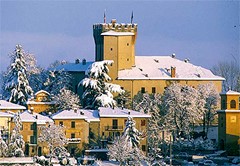Guiglia and the domination of the Montecuccoli.
The village of Samone
Thanks to its particular location, perched on top of a hill, Guiglia overlooks the plain as far as the eye can see.
The first news we have of this place is in a parchment from 890 kept in the Nonantola Abbey archives. The historical centre still preserves the appearance of a small medieval city with its narrow streets, the houses leaning against one another, the cobblestones and the porticoes...; access is through a grandiose Baroque arch topped by an eagle, the heraldic symbol of the Montecuccoli and Este families who, along with the Pio, played an important role in running this territory.
Compared to the other fiefdoms possessed from the Middle Ages onwards, the territory of Guiglia was a fairly late entry amongst the Montecuccoli’s possessions. It was Count Francesco who exchanged the Semese fiefdom for that of Guiglia in 1630, thereby changing his title to Marquis. His son, Giambattista, then established the Montecuccoli Laderchi, a branch of the family that was to outlive many others and did not die out until 1873.
In 1643, during the Castro war, waged by Raimondo Montecuccoli on behalf of the Duke of Modena against the papal army of Pope Urban VII, Guiglia suffered serious damage in an attack by the Pope’s troops.
With the war ended, the new marquises transformed the ancient military structure into an elegant and sumptuous nobleman’s palace, for some one of the most beautiful residences in the Dukedom.
This was built around the battlemented tower, the only remains of the fortalice that rose from the summit of the hill. On the outside redundant parts were eliminated, while inside the rooms were enlarged and decorated. The graceful courtyard portico, the monumental entrance and the interior stucco decorations recalled the style of the master craftsmen who were working at the same time on the ducal palace at Sassuolo.
The Village of Samone
A building last owned by the Montecuccoli is now home to a thematic museum that is genuinely one of a kind amongst museums of peasant culture: The Tigella Museum of Samone, set up to maximize one of the main features of gastronomic culture in the mountains of Modena, namely the crescentina and tigella, the food along with its cooking utensils.
The museum was established in the small medieval village of Samone, in the high part of the Municipality of Guiglia, where signs of its ancient history are still much in evidence, in its portals, windows and symbols. The museum is housed in the stunning Sala degli Stemmi of a tall tower house, whose history is narrated on the frescoed walls by coats of arms and floral and vegetal motifs.
Samone was run by a succession of feudatories, from the Pio of Carpi to the Pepoli, and from the Tassoni to the Montecuccoli. It was in this room that the feudatories received representatives of their subjects to hold debates and let their views be known. Here the men from the Community met to discuss problems of government and also, probably in 1682-83, it was where the administrators of Samone decided to raise a protest against the feudatory Giovanni Battista Montecuccoli for the excessive tax burden and his demands for free services.
This imposing building presents no outward signs of its function except for a window overlooking the underpass. Inside, on the other hand, a large room shows traces of a use that remains unclear, but was definitely different from and more important than mere defence.
The inappropriate use of the building and in particular this room, used for a long time as a hayloft, contributed to annulling the memory of its historical and artistic value, today thankfully recouped.
On leaving the museum it is worth visiting the building beside the church which is a characteristic and rare metato, a place for drying chestnuts, now skilfully restored.
